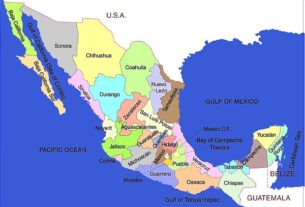If you are going to drive much in Mexico, you need to become at peace with the way Mexican mechanics work.
In the old days (1970’s and 80’s) the smart driver touring Mexico would take a VW and have no problems in getting it fixed. The local mechanics know this car and, other than some small problems with the difference in engines from German models (like we used to buy in the US) and local Mexican produced models, they could fix anything. There is something to be said, even today, about considering buying a VW if you are going to be in Mexico long. There are parts and service available everywhere. However, now the VW models sold in the US and Canada have a lot of electronics in them which are not so easy to fix.
I learned the hard way how to say ‘no’. Our host, a dear family friend, and his family always insist we stay with them on their ranch. They have visited us quite frequently in the US and in fact we even helped one of their daughters find a nice man and get married. We drove our Toyota 4-Runner from our then Missouri farm to their near Mexico City farm. It is always a lot of fun to do these trips. I try and pick unique and different routes so that we see more of Mexico each time. There is something ‘right’ about driving in towns where we see few other gringos and can enjoy the scenery.
When we arrived at the ranch, our friend told me that he thought our brakes were making strange noises–I didn’t hear it myself, but agreed to letting his mechanic take a look. We were busy for the week—a lot of parties, dinners, and siestas. Every night my friend would take down a different bottle of whiskey for us to try. The truck came up in conversations, but I didn’t worry much about it.
After 7 days I thought to myself “Maybe I had better go and take a look” so we went. To my amazement there I found the entire brake system, down to the main cylinder, on the floor of the garage. The mechanic had never worked on a Toyota before and was enjoying exploring it, but it was obvious that he was in over his head. He had decided that my main cylinder was bad so he was trying to find a part, but there was none in all of Mexico. Finally on the 10th day it arrived from the US and he installed it. We were sad to leave our friends but needed to get back to N. Missouri.
Off we drove and all of a sudden it became obvious that we had major problems. The brakes were locking up on their own. A decision had to be made–do we try and find help again or do we drive on? We thought it out logically and decided that we weren’t going to find anyone who had parts or knew what to do, so we drove on, the brake linings burning as we drove. 12 hours later we arrived at McAllen, Texas and you could smell us coming. The border folks were semi-amused–they were wondering why our wheels had brake dust all over them and a dull smell. The drug dogs didn’t like what they smelled–probably burnt their sensitive noses.
We slept well that night, tired from worrying about not having brakes while driving through through mountain passes. I found a Toyota dealership and went in. The dealer looked at my 4-Runner and told me that we had a few major problems:
- The brake shoes installed were Mexican shoes made out of asbestos which are illegal in the US and not very good, and
- The master cylinder that was installed in our 4Runner was for another vehicle and that is why it was malfunctioning.
$1200 later we were back on the road.
Since then I have decided that any offers to fix my vehicle unless it is truly limping, are met by a smiling and pleasant “No thanks”. I should say this doesn’t count though, when it comes to bodywork. I have always been amazed at how the body work people work in Mexico. Many times I have arrived in my wife’s hometown in Gt. Zamora with a dent or a ding and one of my father-in-laws friends will take the vehicle and mysteriously the next morning it arrives back looking better than new. We have seen the ‘hammermen’ in Tijuana and some other places. The first time we saw them I was sort of surprised–who are these people who bang hammers together standing on the road? Then I learned that this is how they advertise their service. They are experts at hammering out dents, often without needing to repaint. Their services are inexpensive. Just be sure you have negotiated the rate. Many times I have paid for my trip in the savings of body work that my insurance would’t have paid for due to a deductible.
I find people in Mexico to be very helpful, almost to the point of being overly helpful. If you said yes to every offer of help you would never get out of the country. Cars in Mexico are revered—you will see people polishing their cars, which I later learn are sometimes models that are 15 years old and look like new. People keep their cars in good shape and clean. I think that one should carefully study what kind of car they are going to drive into Mexico, especially if you are going to live there for a while. Japanese cars are probably not the ticket due to the lack of parts and knowledge. US cars are fairly easy to find parts for since there are dealers for Ford, GM, Chrysler everywhere. I still admire VW Combi buses which can be easily fixed but you may find yourself being mistaken for the route buses that act like taxis. If you have a vehicle that requires difficult parts it might be to your advantage to bring along a spare part of two. Also perhaps a service manual. If you may need to give a gift to someone, wrenches or other high quality car repair tools, while inexpensive in the US, may be a much appreciated gift.
Driving 12 hours in Mexico with brakes that are locking and unlocking may not sound like fun, but in the scheme of things it makes for an interesting time in retrospect. I have driven thousands and thousands of miles and had little trouble in Mexico with my cars or trucks. For me the way to see Mexico is through your windshield and I urge all to try it.
Just learn to say no when a friends mechanic wants to learn about Japanese vehicles by working on yours.
Editor’s Note: In Mexico, Honda and Nissan vehicles are readily available as well as parts (There is a Honda factory in El Salto, Jalisco which has been producing since 1995, and a Nissan factory in Aguascalientes, Aguascalientes). Although parts for GM, Ford and Chrysler are readily available, some parts that are manufactured here in Mexico, for use in Mexican GM, Ford and Chrysler vehicles, ARE NOT compatible with those made in the US and Canada for vehicles produced there. So be careful before you order a part as to whether the compaibility issue applies.


